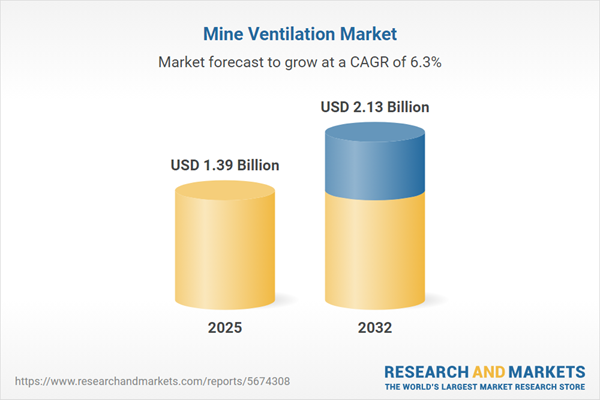Speak directly to the analyst to clarify any post sales queries you may have.
The mine ventilation market empowers executive leaders to address critical safety, compliance, and environmental standards through adaptable technical solutions tailored for complex mining operations worldwide. As operating conditions evolve, proactive ventilation strategies are essential for continuous operational excellence and risk management.
Mine Ventilation Market Snapshot
The global mine ventilation market is demonstrating robust expansion, reaching a value of USD 1.30 billion in 2024. The sector is projected to grow to USD 1.39 billion by 2025, advancing at a compound annual growth rate (CAGR) of 6.29%. By 2032, the industry is expected to achieve a total valuation of USD 2.13 billion. This upward trend is driven by increasing implementation of advanced ventilation systems that reinforce safety and enhance energy management protocols. As both regulatory landscapes and operational standards become more stringent, the mine ventilation market is gaining momentum among established players and in emerging mining jurisdictions worldwide.
Scope & Segmentation: Mine Ventilation Market Analysis
This comprehensive report lets decision-makers examine the factors shaping the mine ventilation ecosystem, with a close look at core segments and global operational contexts:
- Product Types: Solutions for underground and surface mining, each addressing specific regulatory and operational challenges unique to their environments.
- Components: Includes axial fans, centrifugal fans, filtration systems, dampers, air regulators, and intelligent sensors, all integrated to deliver automated air quality management and operational safety measures.
- End Use Sectors: Targeted support for coal, metals, and minerals extraction, each facing distinct compliance requirements and operational risks.
- Mounting Options: Both portable and fixed systems, enabling flexible deployment and permanent infrastructure solutions as required by diverse mining projects.
- Airflow Volume Tiers: Customized capacities suitable for small to large-scale operations, designed for investment scalability and efficiency improvement.
- Geographies: Market coverage across the Americas, Europe, Middle East, Africa, and Asia-Pacific, highlighting the impact of climate conditions, governance standards, and regional investment drivers on supply and adoption rates.
- Leading Industry Players: Market advancement led by Howden UK Limited, TLT-Turbo GmbH & Co. KG, FLÄKTGroup Holding GmbH, The Weir Group PLC, ABB Ltd, Atlas Copco AB, Epiroc AB, Sandvik AB, Komatsu Ltd, and Ingersoll Rand Inc.
Key Takeaways for Senior Decision-Makers
- Centralized digital platforms for mine ventilation provide real-time operational insights, enabling quicker responses to shifting compliance and operational needs across mining portfolios.
- Automation and advanced environmental controls support more streamlined management practices, contributing to improved risk mitigation and progress on sustainability goals.
- Continuous air quality monitoring increases confidence among stakeholders by enabling early detection and reduction of potential hazards on site.
- Deployment of modular and standardized components allows for faster system installation, enhanced adaptability, and smoother regulatory adjustments as standards shift.
- Collaboration with solution providers makes it possible to develop ventilation strategies tailored to the regulatory and environmental requirements of each site.
- Adoption of regional sourcing and supply models sustains ongoing operations and ensures responsiveness to local compliance and evolving market conditions.
Tariff Impact: United States Tariffs Affecting Supply Chains and Pricing
New United States tariffs, scheduled for implementation in 2025, are altering procurement and supply chain frameworks for mine ventilation systems. Mining companies are increasingly diversifying supplier strategies to balance local and international relationships. The move toward modular, standardized equipment designs is also gaining momentum, supporting operational continuity and improved compliance management in the face of changing regulatory requirements.
Methodology & Data Sources
This market analysis is based on direct interviews with mine engineers, product suppliers, consultants, and regulatory authorities. It is further supported by a review of current technical literature, relevant industry standards, and newly published patent updates, ensuring that guidance shared is both reliable and current for strategic decision-making.
Why This Mine Ventilation Market Report Matters
- Enables executive leaders to align infrastructure investments with evolving regulatory and environmental priorities across global mining operations.
- Empowers teams to refine procurement and sourcing strategies for greater market resilience and operational adaptability.
- Provides practical recommendations for benchmarking ventilation system technology and adjusting to compliance developments.
Conclusion
Senior executives can rely on these insights to guide strategic investments and operational adaptations within the mine ventilation sector, ensuring alignment with dynamic regulatory, technological, and environmental demands worldwide.
Additional Product Information:
- Purchase of this report includes 1 year online access with quarterly updates.
- This report can be updated on request. Please contact our Customer Experience team using the Ask a Question widget on our website.
Table of Contents
3. Executive Summary
4. Market Overview
7. Cumulative Impact of Artificial Intelligence 2025
Companies Mentioned
The companies profiled in this Mine Ventilation market report include:- Howden UK Limited
- TLT-Turbo GmbH & Co. KG
- FLÄKTGroup Holding GmbH
- The Weir Group PLC
- ABB Ltd
- Atlas Copco AB
- Epiroc AB
- Sandvik AB
- Komatsu Ltd
- Ingersoll Rand Inc.
Table Information
| Report Attribute | Details |
|---|---|
| No. of Pages | 191 |
| Published | October 2025 |
| Forecast Period | 2025 - 2032 |
| Estimated Market Value ( USD | $ 1.39 Billion |
| Forecasted Market Value ( USD | $ 2.13 Billion |
| Compound Annual Growth Rate | 6.2% |
| Regions Covered | Global |
| No. of Companies Mentioned | 11 |









